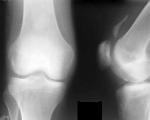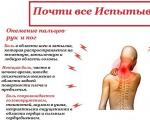Divergence of the pelvic bones after childbirth
The content of the article:The birth of a baby is one of the most beautiful moments in a woman's life. But not always being in the birthing room is pleasant. A woman experiences great pain, which she endures to the last, but after childbirth, pain and discomfort may remain due to changes that have appeared during childbirth. Many women say they have pelvic problems after giving birth. To understand the mechanism of childbirth, you need to know a little about the anatomy of the pelvis.
In order for a child to be born, it must pass through the birth canal, which is formed by the bone pelvis and soft tissues. From the sides of the baby is surrounded by the ilium, ischium and pubic bones. These bones are connected behind by the sacrum with its ligaments, and in front by the pubic symphysis.
The pubic symphysis itself is the fusion of the right and left pubic bones with the help of a cartilaginous disc. Therefore, in its center there is a small joint space in which there is joint fluid. The entire symphysis is surrounded by ligaments that hold it tightly. This articulation is similar to a joint, but it has a very small angle of motion. Normally, the joint space reaches only one centimeter, but the pelvic bones diverge before childbirth, and this distance becomes large. In front of the pubic joint is the pubis, which is represented by adipose tissue and a ligament that lifts the clitoris. Nerves and blood vessels pass behind the pubic bones, the bladder and its excretory canals are located.
So, do the pelvic bones really move apart after childbirth? Yes. But to be more precise, the pubic joint is stretched.
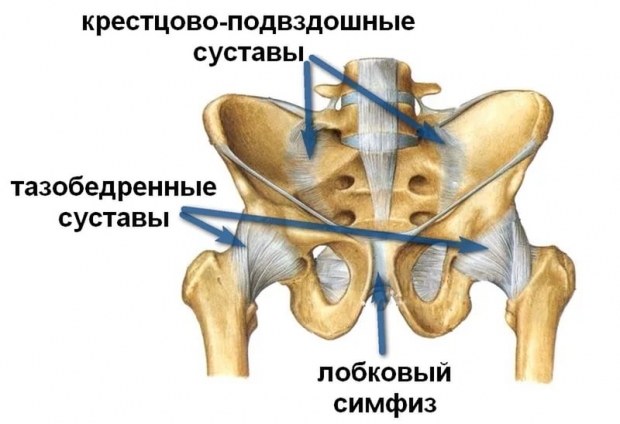
What causes the divergence of the pelvic bones
There is a physiological explanation for this phenomenon. During pregnancy, a woman's pelvis undergoes changes in order to make childbirth as easy as possible. Any woman can argue that there is nothing easy in the process of giving birth to a baby. But if there were no changes in the bones of the pelvis during pregnancy, childbirth would be like a horror movie. Both the baby and the mother must remain healthy and alive, so there are normal changes in the articulation.
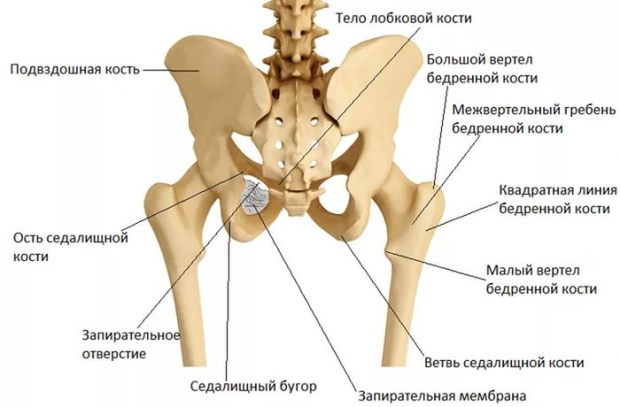
During pregnancy, the ovaries and placenta produce a substance called relaxin. As the name suggests, it has a relaxing effect. Relaxin, mixing with female sex hormones, causes swelling of the ligaments and cartilage of the semi-joint, they become loose. In addition, small gaps filled with fluid form in the joint. The friability of the ligamentous apparatus and the joint fluid give the pelvis greater mobility. Between all the bones of the pelvis there is a discrepancy.
But most of all, these changes affect the pubic symphysis, blood supply to it increases. As a result, the ligaments and soft tissues swell, which increases the articulation in size, the gap expands by millimeters. In addition, the symphysis can move up and down, as if the keys of an instrument. As a result, the gap can increase to several centimeters. The junction of the sacrum diverges minimally, but after delivery, the pelvic bones will fall into place. Joint gaps will again become dense, ligaments and cartilage will acquire their elasticity. But other factors can also be the cause of the divergence of the pelvic bones.
Excessive divergence of the pubic symphysis leads to changes in the osteoarticular system of the body. This takes on the appearance of pathology, the pelvis after childbirth brings discomfort and pain. This phenomenon is called symphysiopathy, and toxicosis becomes the main role in its appearance.
And also the following factors affect the skeletal system:
Violations in phosphorus-calcium metabolism. The main structural component of teeth and bones is calcium. The hormone, calcitonin, and vitamin D regulate the metabolism of calcium and phosphorus in the body. Calcitonin is produced by the parathyroid glands, and the synthesis of vitamin D occurs with the participation of the thyroid gland. Therefore, during pregnancy, the nutrition of a woman is very important, the diet should have enough phosphorus and calcium. With a shortage of these elements, they will come out of their depots - bones and teeth. As a result, the bones will be subject to pathological influence.
With vitamin D deficiency, there is a violation in the metabolic processes of the intestine, where calcium and phosphorus are absorbed. Micronutrient reserves are drawn from the bones, which leads to demineralization. In the absence of calcium in the blood, other problems may appear, such as: kidney failure, gastrointestinal pathology.
Dysfunction of the pubic joint
One of the causes of the pathological divergence of the symphysis is DLS. There are three stages in the pathogenesis of this phenomenon:
1. The period before childbirth. Leading links: heredity, low back pain in early pregnancy, hypo- or hyperactivity, use of oral contraceptives, traumatic injuries of the pelvis or back. It is possible to develop DLS in multiparous women.
2. The birth itself. Obstetric surgery, large or overdue fetus.
3. The period after childbirth. Lactation.
Symptoms
Now it became clear that symphysiopathy leads to the divergence of the pelvic bones. The first signs may appear during pregnancy. Since the calcium depot is depleted, teeth begin to crumble, night cramps, fatigue, paresthesia appear, brittle nails develop. With a slight divergence of the symphysis, pain appears, they are volatile in nature and are very similar to osteochondrosis or sciatica. Pain in the later stages appear with prolonged standing, walking. They are more pronounced, which makes you change your posture. Therefore, a woman should not wonder: how to expand the pelvis before childbirth, nature itself will do everything.
Symphysiopathy occurs most often in a latent form, the uterus increases in size with pregnancy. But the symphysis is firmly held by the abdominal muscles, immediately after the muscles become more flabby, and the symphysis can diverge up to several centimeters. What to do if the pelvic bones parted during childbirth? Most likely, they parted from the weakening of the muscles of the abdominal wall. Depending on the distance between the pubic bones, there are:
1 degree of discrepancy - from 5 to 10 mm;
2 degree - from 10 to 20 mm;
Grade 3 - from 20 mm or more.
Diagnostics
It is not difficult to diagnose 2 and 3 degrees of discrepancy. Pain sensations acquire a permanent character, become clearer with a change in posture, movement of the legs, with the act of defecation. To relieve pain, the woman sits on the bed, her posture is very similar to a frog - knees bent, hips looking to the sides, arms turned outward. How to narrow the pelvis after childbirth, if the discrepancy is more than 2 centimeters, and the gait is similar to a duck, the doctor will tell. Indeed, in this case, during palpation of the pubic joint, there will be pain that radiates to the vagina and forward. When you try to press your index finger, the pillow is quietly placed there. But in order to accurately establish the diagnosis, it is necessary to conduct an ultrasound and x-ray diagnostics. During pregnancy, it is better to use ultrasound, it will detect both discrepancy and pathology in the bones. An x-ray is harmful to the fetus, and it also only shows the presence of a discrepancy.
In addition, you need to check the content of magnesium and potassium ions in the venous blood and in the urine. In the pathology of the articulation, a decrease in values by almost 2 times is observed, at a time when the numbers in the urine can exceed the reference values. The use of laboratory methods helps to suspect pelvic dehiscence even when a woman does not feel pain or discomfort in the pelvic area.
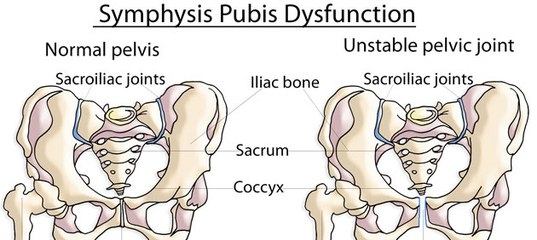
Treatment
Do the pelvic bones converge after childbirth? Yes. With a divergence of the pubic symphysis, surgical intervention is not required. With a slight distance between the bones immediately after childbirth, the doctor recommends reducing physical activity. During pregnancy and after, it is important to wear a bandage that will hold the symphysis together with the abdominal muscles in strength. In addition, it is better to purchase an orthopedic mattress so that the spinal column is unloaded and does not bring unnecessary back pain. Of the measures aimed at strengthening the muscles and ligamentous apparatus, it is worth choosing preparations of potassium, magnesium, for bones - calcium. It will not be superfluous to take B vitamins, sunbathing, which will help to absorb microelements.
If the distance between the pubic bones exceeded 1 cm, then you should think about how to reduce the pelvis after childbirth. Firstly, you need to bring the bones closer together, and secondly, keep them in this position. Bed rest meets the tasks set, how long does the pelvic bones converge after childbirth in different women? After all, not every mother can lie in bed from 2 to 6 weeks, you can not only walk, but also get up. In addition, the pelvis should be tightly bandaged, after which a bandage is put on.
Exercises for the small pelvis can be avoided if, immediately after childbirth, ice is applied to the symphysis area and a course of physiotherapeutic procedures is taken. Reinforcing treatment will be the intake of vitamins, calcium supplements and, if necessary, painkillers. It happens that along with the discrepancy, symphysitis is diagnosed, then you need to add antibacterial drugs to the treatment. The very nutrition of a woman should be rich in calcium, magnesium and potassium.
After the above procedures, an X-ray control is needed, on the basis of which a bandage is selected. But when wearing it, it will be possible to get up and feed the baby. But strong loads at first will still be banned. It is recommended to wear a corset for up to six months.
Consequences
Symphysiopathy, as well as the divergence of the pelvic bones, are conditions that proceed extremely favorably. This pathology is not an indication for caesarean section. During childbirth, different techniques are used depending on the degree of divergence of the bones. Only with a strong discrepancy and a danger to the pelvic bones is it recommended to perform a caesarean section.
The most unpleasant thing that symphysiopathy brings to a woman is bed rest and restriction of motor activity. Very rarely, exercises for convergence of the pelvic bones after childbirth can aggravate the situation and lead to a rupture of the symphysis if the distance between the edges of the bones exceeds grade 2. But this happens more often in the birth itself, if the pelvis is initially narrow, and the labor activity is strong.
When ruptured, the bladder can be injured, hematomas can form in the pelvic cavity. They may be accompanied by an inflammatory process. With severe damage to the symphysis during the birth of a baby, urgent surgical intervention is required. After which it will be possible to start physical activity after 4 or more months.
Prevention of the divergence of the pelvic bones will be the right lifestyle, nutrition enriched with trace elements, physical activity. Every woman should know and understand that the health of the unborn baby depends only on her.


